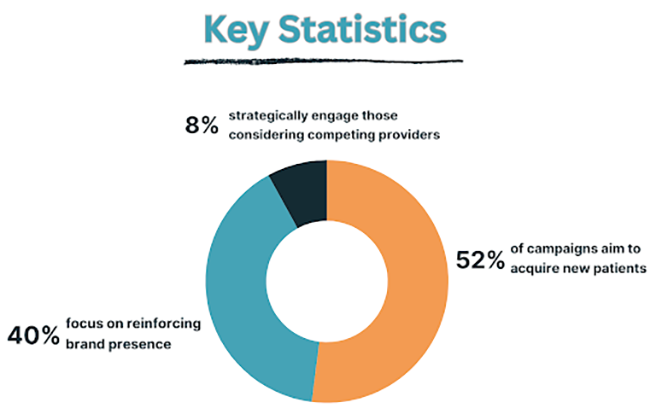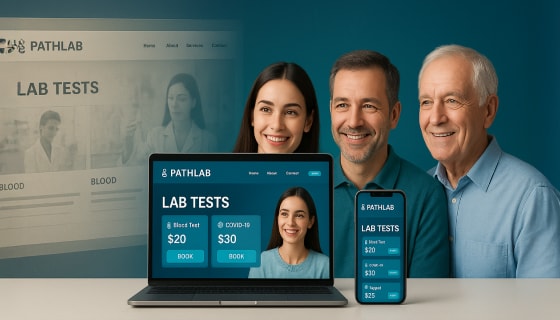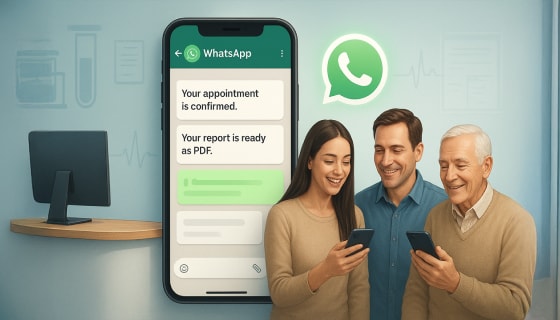With countless joint care ads, second opinions, and self-diagnosis videos popping up on their phones, it’s no surprise that many patients drop out before booking surgery, even if they were almost ready. That’s where retargeting ads come in. A patient may forget to schedule that follow-up. Another might delay their decision out of fear. Retargeting lets you meet them where they left off—gently, helpfully, and with purpose.
In healthcare, retargeting remains underutilized. But for orthopedic specialists, it’s a powerful way to support patients beyond the first click, helping them return with confidence. In this blog, you’ll explore how retargeting ads work in joint replacement services—and how they can help you re-engage patients, increase bookings, and build lasting trust with those who need your care most.
Understanding Retargeting in Healthcare
Not every patient needs to be convinced. Some just need to be reminded.
Retargeting ads are designed to do precisely that—they reach back out to people who visited your website, watched your videos, or showed interest in your joint replacement services but didn’t take the next step. Unlike traditional paid ads that target cold audiences, retargeting focuses on individuals who are already familiar with your brand.
In a clinical setting, this might involve displaying an ad about robotic-assisted knee surgery to a patient who has explored that specific service on your site. It’s personal, relevant, and timed just right. And when done with care, it’s incredibly effective. For joint replacement surgeons, the real impact of retargeting lies in how and when it’s used throughout each step of the patient journey.
To understand why retargeting is such a valuable strategy, especially in healthcare, it’s helpful to examine the primary objectives behind these campaigns.

These numbers reinforce a simple truth: retargeting isn’t just about bringing patients back—it’s also about expanding awareness, building trust, and even reaching those who may be considering other providers.
The Retargeting Funnel for Joint Replacement Surgeons
A patient considering joint replacement doesn’t make a decision overnight. Hesitation, second opinions, and countless questions often mark their journey. During this exploratory phase, they might land on your website, read through patient testimonials, or explore your services, only to close the tab and walk away. That doesn’t mean they’re not interested. It simply means the conversation paused.
Retargeting steps in right at these decision crossroads, re-engaging patients at key stages of their journey, without overwhelming them. It gives your brand the chance to gently follow up, stay visible, and offer helpful information based on where they dropped off.
To understand where retargeting fits into your strategy, let’s look at the most common types used in digital healthcare campaigns—and the core objectives they help fulfill.
| Retargeting Type | Usage % | How It Works |
| Site Retargeting | 87.90% | Re-engages visitors who landed on your site but didn’t book a consultation |
| Search Retargeting | 64.90% | Targets users who searched for terms like “knee replacement recovery” |
| Creative Retargeting | 29.80% | Delivers ad creatives based on a user’s past behavior and interests |
| Email Retargeting | 26.10% | Sends reminders and nurturing emails to prior leads or inquiry submissions |
| Other | 3.10% | Includes CRM, mobile, or custom audience-based strategies |
To make these efforts more effective, you can segment patients based on their intent and behavior. For example:
- A visitor who explored your “Book a Consultation” page might later see a patient testimonial video that builds confidence.
- Someone who read about post-surgery care might be retargeted with a message highlighting your recovery support team.
And at the heart of that personalization lies how you craft your ads, because the message, the tone, and the timing are what turn attention into action.
Crafting Retargeting Ads That Rebuild Trust and Spark Action
Retargeting in healthcare is about more than re-engagement—it’s about rebuilding confidence in the decision to move forward. For joint replacement surgeons, these ads must be crafted with sensitivity, clarity, and purpose. When done right, they don’t just bring patients back—they guide them forward.
At the heart of effective retargeting lies a simple formula: relevant visuals, empathetic messaging, and confidence-building calls to action—each aligned with the patient’s stage in their journey.
Use Visuals That Represent Recovery
Patients don’t connect with clinical scans—they connect with outcomes. Your Patients don’t connect with X-rays or clinical charts. They connect with transformation. Visuals should reflect life after surgery—mobility regained, independence restored, and stories of real patients thriving again.
Think:
- A photo of a smiling patient walking outdoors, weeks after knee replacement.
- A before-and-after range-of-motion image that highlights visible progress.
- A video testimonial featuring a patient who once hesitated, sharing how their life changed post-surgery.
These visuals foster emotional relatability, enabling patients to visualize their future selves, not just the procedure ahead of them.
Write Messaging That Reassures and Educates
Ad copy should never push—it should guide. Whether your audience is hesitant, afraid, or simply unsure, your message should gently address their doubts while offering clarity.
Examples include:
- “Still exploring your options? Discover how others recovered confidently.”
- “See what real recovery looks like—patient journeys, start to finish.”
- “We understand your concerns. Here’s how our process supports you at every step.”
This kind of messaging is effective because it acknowledges the patient’s emotional state and provides reassurance without sounding promotional.
Use CTAs That Align With Intent
In retargeting, patients are already aware of your services; now they need clear, confidence-building next steps. Whether they’re still researching or nearly ready to book, your CTA should match their intent. Adding a time-sensitive offer—like a seasonal check-in or a limited free consultation—can also motivate hesitant patients to take action.
Effective examples include:
- “Watch Real Patient Stories”
- “See If You’re a Candidate”
- “Limited Consultations This Week in [City Name]”
- “Talk to Our Joint Expert in Your Area”
Adding timely nudges, such as seasonal availability or limited slots, can also help encourage hesitant patients to take the next step. And for greater relevance, geo-targeted PPC ads can personalize messaging by location, showing patients services available in their area or city. This improves conversion rates by delivering the right message to the right person at the right time. Discover how geo-targeting can enhance patient acquisition in our blog on PPC for healthcare.
And while well-crafted messaging forms the foundation, it’s the innovative use of AI that takes retargeting from consistent to truly high-performing, by optimizing what’s shown, when, and to whom.
AI-Powered Optimization: Smarter Campaigns, Better ROI
AI has moved beyond automation; it now fuels real-time decision-making across platforms like Google Ads, Meta, and programmatic networks. For joint replacement surgeons using retargeting, this means your campaigns become more intelligent with every impression.
AI in advertising utilizes machine learning algorithms to analyze large datasets, including browsing behavior, engagement patterns, past conversions, and responses by time of day. Instead of showing the same ad to everyone, AI enables your campaign to deliver personalized experiences at scale—automatically optimizing headlines, visuals, audience segments, and placements in real time.
Artificial Intelligence has become truly impactful in predictive targeting for healthcare. It helps to analyse which patients are most likely to seek post-operative support or explore robotic-assisted surgery, before they explicitly ask. AI models can analyze micro-signals, such as repeat visits to specific pages, time spent on surgical FAQs, or abandoned appointment forms, to detect high-intent users. Once identified, these patients can be retargeted with messaging that feels incredibly relevant, such as testimonials, recovery timelines, or consultation reminders. This level of precision boosts ROI and improves the patient experience.
But even the most innovative campaigns must be handled with care, because in healthcare, performance means nothing without privacy, empathy, and ethical responsibility.
Compliance, Sensitivity, and Ethical Messaging
In healthcare marketing, success isn’t just measured by clicks or conversions—it’s also judged by compliance, intent, and compassion. Across the globe, multiple governing bodies exist to regulate healthcare communication.
In India, healthcare marketing must adhere to the Code of Ethics Regulations, 2002, as issued by the Medical Council of India (MCI). One lesser-known but important guideline from this code is that physicians must not use testimonials or endorsements in advertising if they are self-promotional or misleading, which can directly impact how retargeting campaigns are structured.
When it comes to patient data protection, India has implemented the Digital Personal Data Protection Act, 2023, which focuses on safeguarding individuals’ privacy and personal information. This act aligns closely with similar frameworks, such as HIPAA in the US and GDPR in the EU, aiming to ensure that healthcare providers handle patient data responsibly, especially in the context of retargeting ads, where privacy is paramount.
Retargeting must never feel intrusive, especially when it comes to personal health decisions. Patients may have searched for joint replacement services during moments of vulnerability or physical discomfort. Serving an overly aggressive ad that reminds them of a condition they haven’t disclosed to others can feel invasive and even distressing.
To avoid this, ensure:
- You’re not retargeting based on personal health data (only behavioral data, such as site visits).
- You avoid naming specific conditions in the ad copy (e.g., “Still suffering from severe hip pain?” is inappropriate). You use inclusive, supportive language that reinforces trust (e.g., “Considering options for better joint health?”).
The difference lies in tone, intent, and responsibility. While the compliant ad builds trust through empathy and education, the non-compliant one uses fear and false promises, risking both ethical violations and patient discomfort.
Measuring What Matters: KPIs for Retargeting Campaigns
Key Performance Indicators (KPIs) are your roadmap, guiding you toward smarter decisions. For joint replacement surgeons, tracking the right KPIs ensures that your retargeting efforts not only reach the right patients but also encourage them to take action.
Here are the most critical KPIs to focus on:
Impressions vs. Conversions
Impressions measure how often your ad is displayed, but conversions indicate how often those impressions result in meaningful actions (e.g., booked consultations). A high number of impressions might seem impressive, but it’s the conversion rate that matters most. For example, if an ad generates 1,000 impressions but only results in 5 consultations, the real question is: why aren’t more of those impressions turning into leads? By tracking both metrics, you can pinpoint where the ad’s messaging or timing may need adjustment.
Cost per Consultation (CPC)
Cost-per-consultation is one of the most reliable key performance indicators (KPIs) for evaluating return on investment (ROI) in retargeting campaigns. This metric tells you exactly how much you’re spending to convert a lead into a patient consultation. By measuring this consistently, you can optimize your ads for better cost efficiency, ensuring that your marketing budget is being used to its fullest potential.
Return on Ad Spend (ROAS)
ROAS measures the revenue generated for every dollar spent on ads. If you spend ₹1,000 on retargeting ads and generate ₹5,000 in consultations, your ROAS is 5:1. A high ROAS indicates that your ads are well-targeted and effectively prompting patients to book consultations. Tracking this metric ensures that your investment in retargeting is delivering measurable, profitable results.
While it’s tempting to focus on numbers like click-through rates and impressions, ad quality is just as important, if not more so. Quality isn’t just about how many people click on your ad; it’s about how relevant and engaging your ad is to the right audience.
To evaluate ad quality, focus on:
- Look beyond clicks and assess the time spent on your landing page or the number of patients watching video testimonials.
- Analyze how your ad resonates with the patient’s current stage in their journey. Ads that match their interests and needs will naturally perform better.
- Get the clarity on your messaging. A straightforward and easy-to-understand ad will engage the patient, whereas an ad that confuses will lead to a drop in conversions.
By combining these metrics and refining them based on insights, you can ensure that your retargeting campaigns reach the right patients and also move them toward the next step in their healthcare journey.
Conclusion
The future of healthcare marketing lies in retargeting, with 50% of marketers planning to increase their budgets for it over the next six months. By absorbing the insights from this blog, you’ve already set yourself apart from those who are still behind.
Now, it’s time to turn those insights into action. Partner with ZealousWeb, and let us guide you in executing powerful retargeting campaigns that will attract, engage, and convert more patients for your orthopedic clinic. Schedule a 30-minute complimentary strategy call with us today to discover how we can enhance your retargeting efforts, increase consultations, and boost patient acquisition.













